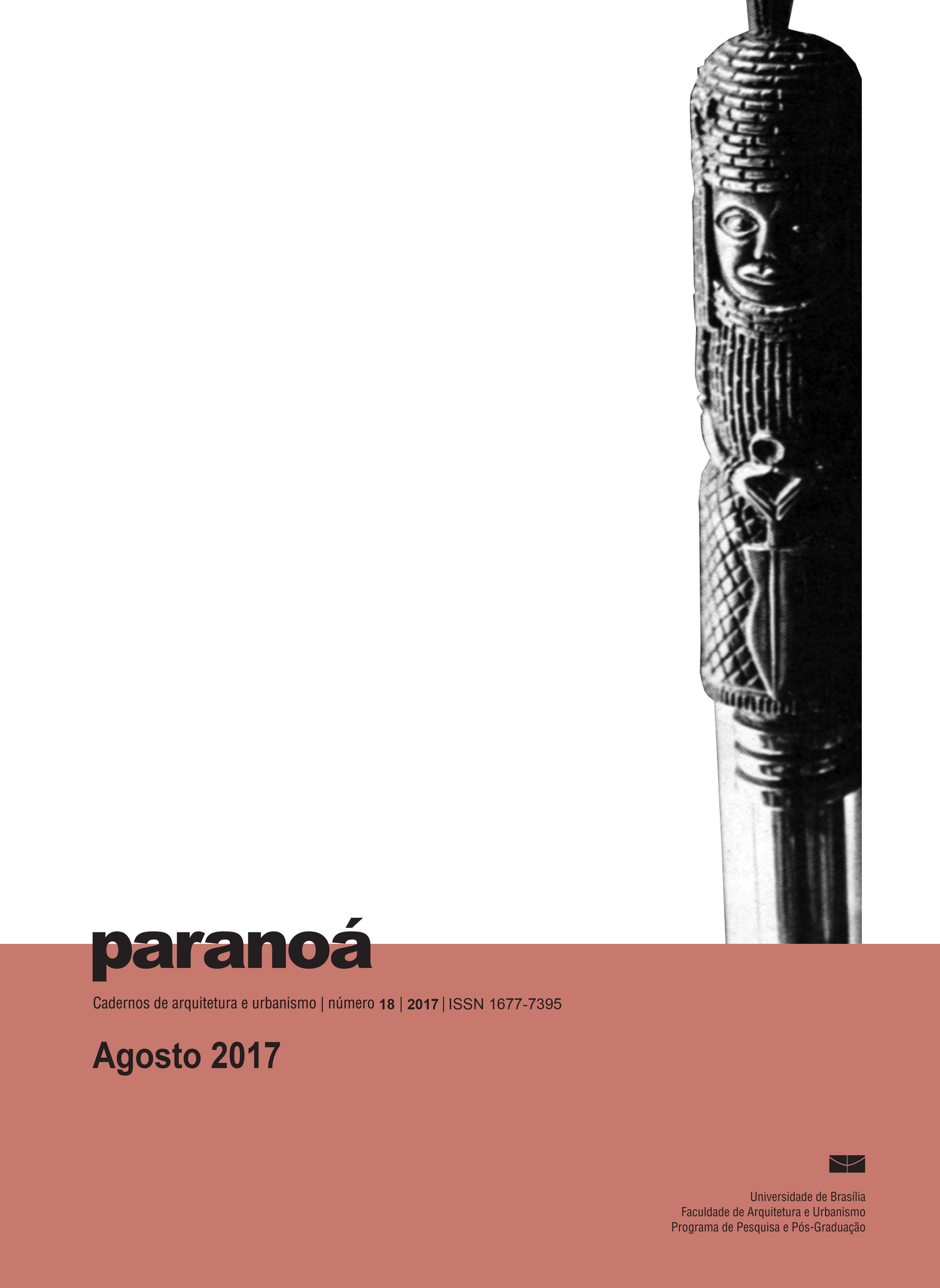Modern Movement mediations: brazilian Modernism and the identity of post-war Architecture in Pretoria, South Africa
DOI:
https://doi.org/10.18830/issn.1679-0944.n18.2017.04Palabras clave:
Movimento Moderno, Brasil Builds, Hellmut stauch, Oscar NiemeyerResumen
A arquitetura brasileira de Oscar Niemeyer inspirou o desenho de um grande número de construções sulafricanas. Este artigo contextualiza as mediações do movimento moderno e aponta similaridades em aproximação com a identidade, contexto e uma série de eficiências a partir de uma comparação do prédio do Ministério da Educação do Rio de Janeiro, de Niemeyer, 1945 e o prédio do Meat Board de Pretoria, de Helmut Stauch, 1952.
Descargas
Citas
ANON. Meat Board Building, Pretoria. Architect and Builder. September, p. 54-61, 1952.
ANON. Modular office building. Architectural Forum, February. p. 146-149, 1953a.
ANON. Three Pretoria Houses. Architect and Builder, April, p. 34-49, 1953b.
Barber. D. Le Corbusier. The Brise Soleil and the Socio-Climatic Project of Modern Architecture. Retrieved from <http://www.academia.edu/10112316/Le_Corbusier_The_Brise-Soleil_and_the_Socio-Climatic_Project_of_Modern_Architecture_1929-1963> [Accessed 16 March 2017].
BARKER, A. Heterotrophic syntheses: mediation in the domestic architecture of Gabriël (Gawie) Fagan. Pretoria: Unpublished PhD, University of Pretoria, 2012.
BENTON, T. The Modernist House. London: V&A Publications, 2006.
CHIPKIN, Clive M. Johannesburg Style: Architecture and Society 1880s ”“ 1960s. Cape Town: David Philip, 1993.
CLARKE, N. Architectural history of the capital. In Matthews, P.J. (ed.).
Contemporary capital: an architectural journal. Pretoria: Visual Books, 2011.
COOKE, J. A biographical history: Helmutt (sic) Stauch. In Beck, H. (ed.). UIA International Architect: Southern Africa, (8), p. 61, 1985.
COOKE, J. Revisions of the Modern. In Architecture of the Transvaal. Edited by R.C. Fisher & S. le Roux with E. Maré. Pretoria: University of South Africa, 1998, p. 231-251.
COOKE, J. Shifts after the Thirties. Architecture South Africa, (7/8), July/August, p. 23-30, 1993.
CURTIS, W. Modern Architecture since 1900. London: Phaidon, 1996.
DE BEER, I. Brazil. In Architecture 2000. Edited by I. Prinsloo. Johannesburg: Picasso Headline, p. 109-110, 2000.
FAGAN, G.T. & G. Interview with the author on 26 March 2008. 156 Bree Street, Cape Town, 2008.
FASSLER, J. Contemporary Architecture in South Africa. Architectural Design. June (6), p. 176-179, 1956.
FISHER, R.C. The Third vernacular. Pretoria Regionalism - aspects of an emergence. In Architecture of the Transvaal. Edited by R.C. Fisher & S. le Roux with E. Maré. Pretoria: University of South Africa, 1998, p. 123-147.
GERNEKE, G. Oscar Ribbeiro de Almeida Niemyer Soares Filho (1907-2012). Architecture South Africa. Issue 65, Jan/Feb, 2014, p. 39-45.
GERNEKE, G. From Brazil to Pretoria ”“ The Second Wave of the Modern Movement. In Architecture of the Transvaal, First edition, edited by R.C. Fisher, S. le Roux & E. Mare. Pretoria: University of South Africa, 1998, p. 216-217 & 224 ill.
GHIRADO, D. Architecture after Modernism. Thames & Hudson, 1996.
GOODWIN, Philip L. BRAZIL BUILDS. Design; Mar 1, 44, 7; Periodicals Archive Online, p. 10, 1943b.
GOODWIN, Philip L. BRAZIL BUILDS. Museum of Modern Art, New York, 1943a.
HERBERT, G. Martienssen and the International Style: the modern movement in South African Architecture. Cape Town: A.A. Balkema, 1975.
HEYNEN, H. Architecture and Modernity. Cambridge: MIT Press, 1999.
HOWIE, W.D. 'The Meat Board building, Pretoria'. South African Architectural Record, September, p. 212-222, 1952.
JENCKS, C. Modern Movements in Architecture. Garden City, N.Y: Penguin, 1985.
JOEDICKE, J. Architecture since 1945. London: Pall Mall, 1969.
Lexicon. Little Brazil. Artefacts. 2017. Retrieved from.
http://www.artefacts.co.za/main/Buildings/style_det.php?styleid=70 [Accessed 14 March 2017].
MCINTOSH, W.G. Pretoria's architecture: present and future. South African Architectural Record, May, p. 22-23, 1956.
Meat Board Building, 140 Hamilton Avenue, Arcadia, Tshwane. Ablewiki. 2010. ABLEWIKI:NipilarHouse. Retrieved from <http://wiki.up.ac.za/index.php/ABLEWIKI:NipilarHouse> [Accessed 14 March 2017].
MULLER, C.J.F. Five Hundred Years - A history of South Africa. Pretoria, Cape Town: Academica, 1984.
NATION, S. The background, architectural philosophy and work of Hellmutt Wilhelm Ernst Stauch. Unpublished Master's thesis. University of Pretoria: Pretoria, 1985.
PETERS, W. Houses for Pretoria. In Architecture of the Transvaal. Edited by R.C. Fisher & S. le Roux with E. Maré. Pretoria: University of South Africa, 1998, 175-195.
PETERS, W. The importance of the '30s in the Domestic Architecture of Hellmut Stauch. Architecture South Africa, January/February, p. 23-29, 1987.
PEVSNER, N. Johannesburg: Meat Board Building. The Architectural Review. Vol. 113. Number 678. June, p. 375, 1953.
PRINSLOO, I. (ed.). Architecture 2000: A review of South African Architecture. Johannesburg: Picasso Headline, 2000.
SILVERMAN, M. 'Ons bou vir die Bank': Nationalism, architecture and Volkskas Bank' in Blank, Architecture Apartheid and After. 1999, p. 129-143.
ST. JOHN WILSON, C. The other tradition of Modern Architecture - the uncompleted project. London: Blackdog, 2007.
STAUCH, H.W.E. 'A modern office building'. REPRINT: Public Works of South Africa, July p. 1-8, 1951.
Descargas
Cómo citar
Número
Sección
Licencia
Autores que publicam nesta revista concordam com os seguintes termos:
- Autores mantém os direitos autorais e concedem à revista o direito de primeira publicação, com o trabalho simultaneamente licenciado sob a Licença Creative Commons Attribution que permite o compartilhamento do trabalho com reconhecimento da autoria e publicação inicial nesta revista. http://creativecommons.org/licenses/by/4.0
- Autores têm autorização para assumir contratos adicionais separadamente, para distribuição não-exclusiva da versão do trabalho publicada nesta revista (ex.: publicar em repositório institucional ou como capítulo de livro), com reconhecimento de autoria e publicação inicial nesta revista.
- Autores têm permissão e são estimulados a publicar e distribuir seu trabalho online (ex.: em repositórios institucionais ou na sua página pessoal) a qualquer ponto antes ou durante o processo editorial, já que isso pode gerar alterações produtivas, bem como aumentar o impacto e a citação do trabalho publicado (Veja O Efeito do Acesso Livre).















